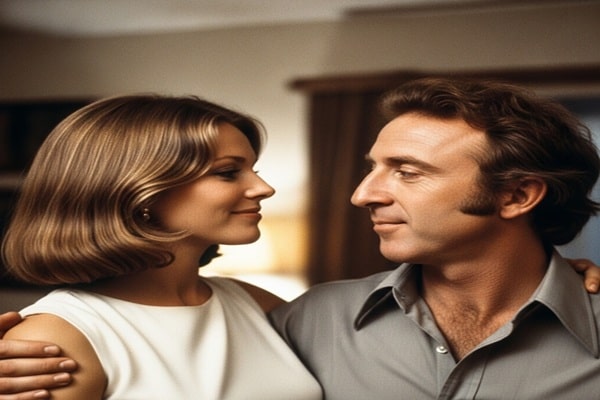
When you think of Gene Wilder, your mind probably jumps straight to Willy Wonka & the Chocolate Factory or his hilarious pairings with Richard Pryor. But behind the laughter and silver-screen magic stood Mary Joan Schutz, a woman whose influence on Wilder’s life is rarely told—but is absolutely essential to his story.
Mary Joan’s life was a delicate balance between Midwestern values and the whirlwind of 1960s Hollywood. Her seven-year marriage to Wilder coincided with some of his most memorable performances, yet she remained largely out of the spotlight, quietly shaping one of comedy’s most beloved figures. Here’s a closer look at her life, legacy, and lasting impact.
Early Life and Midwest Roots
Mary Joan Schutz was born on January 12, 1930, in Iowa, at a time when the Dust Bowl and Depression-era struggles defined daily life. Her parents, Matthew Lynn Schutz and Katherine Marie Hickey, instilled in her the resilience and grounded values that would carry her through the Hollywood whirlwind years later.
Her family was a mix of immigrant dreams and strong cultural roots:
-
Belgian heritage: Her grandfather, Ferdinand Joseph Schutz, crossed the Atlantic seeking the American dream.
-
Irish resilience: On her mother’s side, the Hickeys passed down stories of determination and perseverance.
Growing up during challenging times, Mary Joan learned the importance of finding joy in simplicity and strength in quiet moments—skills that would prove invaluable when cameras began flashing around her.
A Fateful Meeting in the 1960s
Sometimes, destiny shows up in the form of family introductions. Mary Joan met Gene Wilder through his sister, a meeting that would eventually shape Hollywood history.
At the time, Gene was immersed in New York’s experimental theater scene, honing the authentic, quirky energy that would later define his career. He wasn’t yet a household name, but his charm and magnetic presence were undeniable.
Mary Joan wasn’t just any single woman—she came with her daughter Katharine from a previous relationship. Gene embraced both her and her child without hesitation, showing early on the compassion and integrity that marked his personal life.
Marriage and the Hollywood Years (1967–1974)
On October 27, 1967, Mary Joan Schutz became Mrs. Gene Wilder. Their wedding marked the beginning of one of Hollywood’s more stable marriages during a turbulent era for the entertainment industry.
Gene adopted Katharine, giving her his surname and solidifying the bond between stepfather and daughter. This step reflected the genuine family values Mary Joan and Gene shared, which formed the bedrock of their household.
During their marriage, Wilder’s career skyrocketed with iconic roles in:
-
The Producers (1967)
-
Willy Wonka & the Chocolate Factory (1971)
Mary Joan chose to stay out of the spotlight, focusing on creating a stable home for their family. Unlike many celebrity wives who chased fame, she prioritized family over public recognition, giving Gene the freedom to flourish creatively.
Supporting a Rising Star
Mary Joan’s support went beyond the ordinary. She understood that a healthy home life was critical to Wilder’s ability to take risks on stage and screen.
-
She attended premieres and events when necessary, always presenting grace and discretion.
-
She provided emotional stability, allowing Wilder to navigate Hollywood’s pressures without losing his sense of self.
Her quiet approach offered a stark contrast to the often chaotic Hollywood lifestyle, helping Gene focus on his craft rather than distractions.
Also Read : Who is Melissa Ann Piavis? The Untold Story of Big Show’s First Wife
Navigating Hollywood’s Social Scene
Being married to Gene Wilder meant entering Hollywood’s complex social world. Mary Joan managed this with authenticity and poise, earning respect from peers and industry insiders.
-
She maintained friendships with other actors’ spouses, balancing social obligations with personal values.
-
Her Midwestern roots helped her stay grounded, preventing the Hollywood glitter from overshadowing her identity.
This balance allowed her to navigate both fame and ordinary life—a rare skill for anyone in her position.
The End of an Era
By 1974, cracks began to appear in their marriage. Reports suggest that Mary Joan suspected Gene of having an affair with his Young Frankenstein co-star Madeline Kahn. The details remain private, but their marriage officially ended that year.
-
The divorce was handled discreetly, protecting Katharine from media scrutiny.
-
After seven years together, the union concluded, leaving memories of love, support, and shared life experiences behind.
Life After the Spotlight
After her divorce, Mary Joan deliberately stepped away from public life. She focused on raising Katharine and rebuilding her identity outside of Hollywood.
Divorce in the 1970s carried social challenges, particularly for women connected to celebrities. Yet Mary Joan approached these challenges with the same dignity she had shown throughout her marriage.
The separation also created family complications—Katharine became estranged from Gene for years, a rift that reportedly caused him considerable heartache. Despite this, Mary Joan remained a steady, supportive figure in her daughter’s life.
Legacy and Lasting Impact
Mary Joan Schutz’s influence on Gene Wilder is undeniable. During their marriage, she provided:
-
Stability that allowed him to take creative risks
-
Emotional support through Hollywood’s ups and downs
-
A grounded perspective, keeping the family and home life private
Her story also reflects the unseen contributions of many celebrity spouses—women who balance public fascination with personal integrity.
Today, her legacy lives on through Katharine, who became an accomplished actress, and through the foundation she provided for one of comedy’s greatest talents. Mary Joan may have chosen privacy over fame, but her impact is enduring.
Conclusion
Mary Joan Schutz’s story is a testament to love, dignity, and quiet strength. She chose family over celebrity, privacy over public adoration, and stability over glittering allure.
Her contribution to Gene Wilder’s life and career was invaluable—she provided a home base where creativity thrived, where laughter wasn’t performed but lived naturally.
In the end, Mary Joan Schutz reminds us that sometimes the most powerful influences in Hollywood aren’t the ones on screen—they’re the ones standing quietly beside the stars, shaping their worlds with grace and love.


